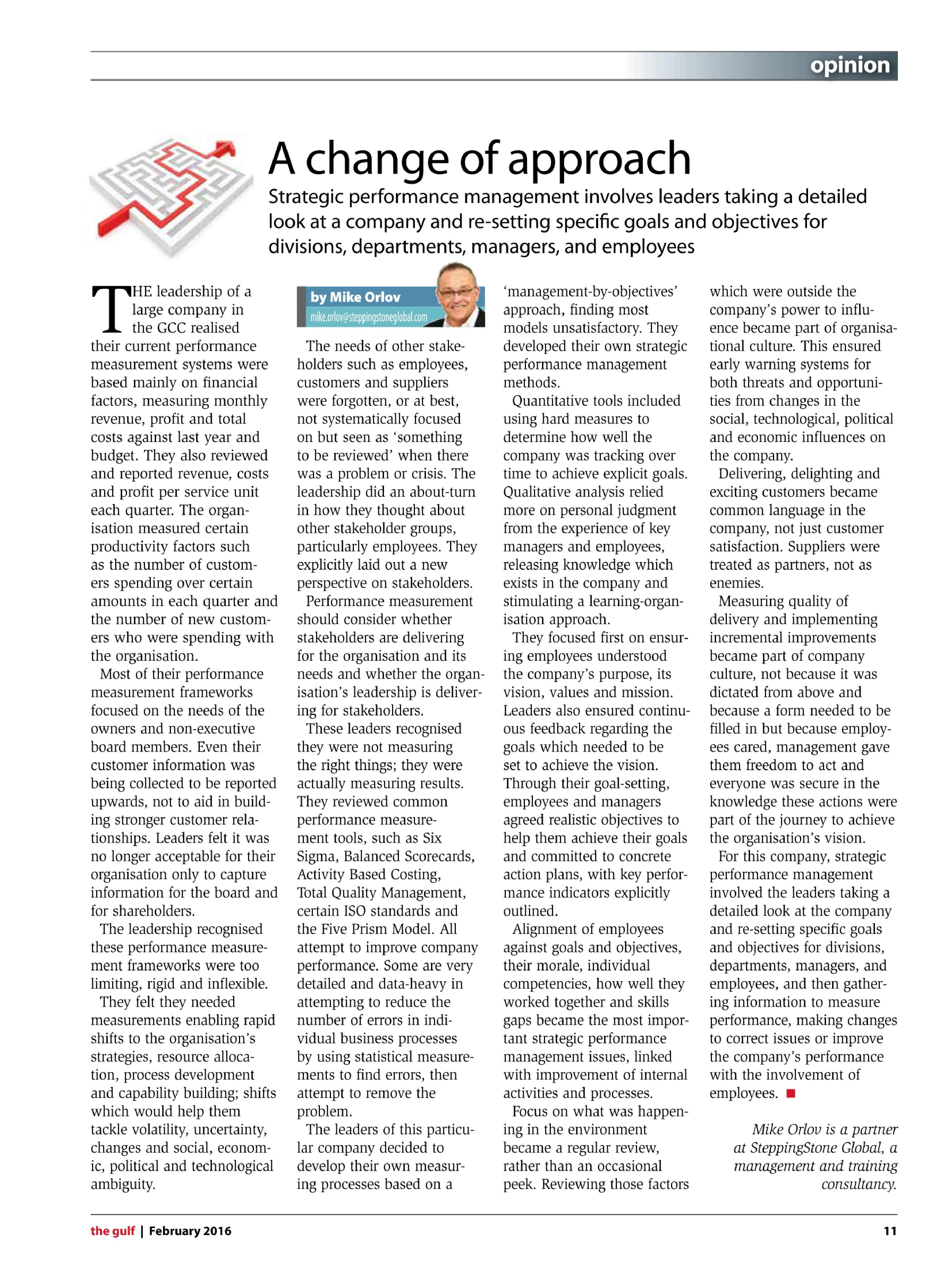 Strategic Performance Management
Strategic Performance Management
Leadership of a large company in the GCC realized their current performance measurement systems were based mainly on financial factors, measuring monthly revenue, profit and total costs against last year and budget. They also reviewed and reported revenue, costs and profit per service unit each quarter. The organization measured certain productivity factors such as the number of customers spending over certain amounts in each quarter and number of new customers who were spending with the organization.
Most of their performance measurement frameworks focused on the needs of the owners and non-executive board members. Even their customer information was being collected to be reported upwards, not to aid in building stronger relationships with customers. Leaders felt it was no longer acceptable for their organization only to capture information for the board and for shareholders.
The leadership recognized these performance measurement frameworks were too limiting, rigid and inflexible. They felt they needed measurements enabling rapid shifts to the organization’s strategies, resource-allocation, process-development and capability-building; shifts which would help them tackle the volatility, uncertainty, changes and ambiguity in social, economic, political and technological environments.
The needs of other stakeholders such as employees, customers and suppliers were forgotten, or at best, not systematically focused on but seen as ‘something to be reviewed’ when there was a problem or crisis. The leadership did an about-turn in how they thought about other stakeholder groups, particularly employees. They explicitly laid out a new perspective on stakeholders.
There had to be a ‘quid pro quo’ between the organization and its stakeholders; all stakeholders, not just owners and the board, expect something from the organization but the organization also wants something in return. Performance measurement should therefore consider whether such stakeholders are delivering for the organization and its needs and whether the leadership of the organization is delivering for the stakeholders.
These leaders recognized they were not measuring the right things; what they were actually measuring were results. They reviewed some of the more common performance measurement tools, such as Six Sigma, Balanced Scorecards, Activity Based Costing, Total Quality Management, certain ISO Standards and the Five Prism Model.
All these are renowned strategic management performance measurement approaches attempting to improve companies’ performances. Some of them are very detailed and data-heavy in their attempts to reduce the number of errors in individual business processes by using statistical measurements to find errors, then attempt to remove the problem.
The leaders of this particular company decided to develop their own measuring processes based on a management by objectives approach, finding most of the models unsatisfactory. They developed their own strategic performance management methods. Quantitative tools included using hard measures to determine how well the company was tracking over time to achieve explicit goals. Qualitative analysis relied more on the personal judgment from the experience of key managers and employees, releasing knowledge which exists in the company and stimulating a learning-organization approach.
They focused first and foremost on ensuring employees understood the company’s purpose, its vision, values and mission. Leaders also ensured continuous feedback regarding the goals which needed to be set to achieve the vision. Through their goal-setting, employees and managers agreed realistic objectives to help them achieve their goals and committed to concrete action plans, with key performance indicators explicitly outlined, ensuring measurement of activity was possible when reviewed.
Alignment of employees against goals and objectives, their morale, individual competencies, how well they worked together and skills-gaps became the most important strategic performance management issues, linked with improvement of internal activities and processes.
Focus on what was happening in the environment became a regular review, rather than an occasional peek. Reviewing those factors which were outside the company’s power to influence became part of the organization’s culture. This ensured early warning systems for both threats and opportunities from changes in the social, technological, political and economic influences on the company, particularly those of high importance, immediacy and impact.
Delivering, delighting and exciting customers became common language in the company, not just customer-satisfaction. Suppliers were treated as partners, not as enemies to be fought with at every turn. Measuring quality of delivery and implementing incremental improvements became part of the company culture, not because it was dictated from above and because a form needed to be filled in but because employees cared, management gave them freedom to act and everyone was secure in the knowledge these actions were part of the journey to achieve the organization’s vision.
For this company, strategic performance management involved the leaders taking a detailed look at the company and re-setting specific goals and objectives for divisions, departments, managers, and employees, and then gathering information to measure performance, making changes to correct issues or improve the company’s performance with the involvement of employees who see themselves as key players in achieving the company’s purpose for all stakeholders
